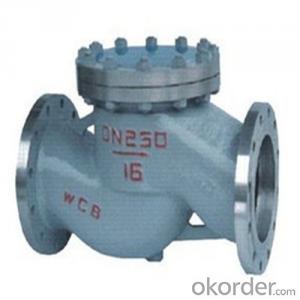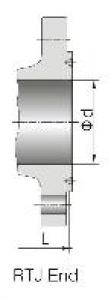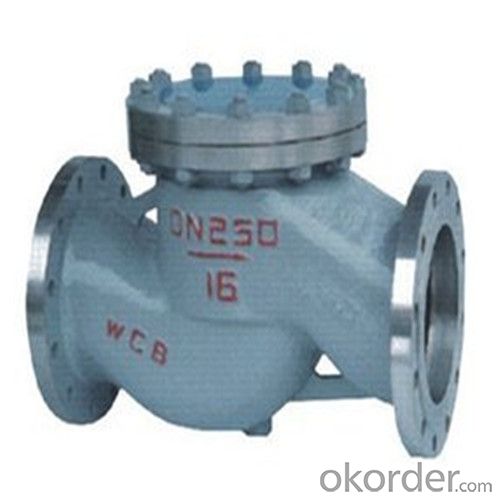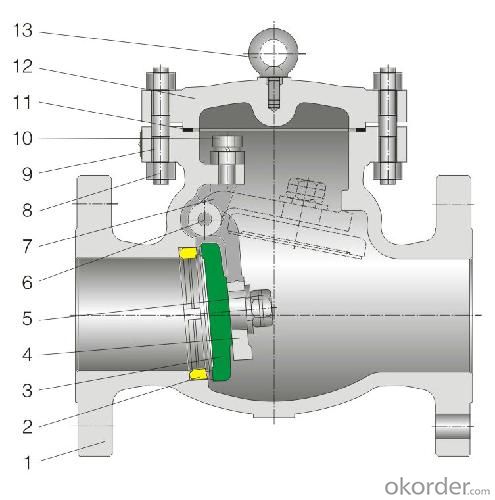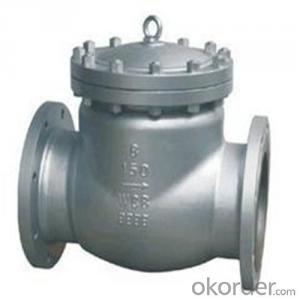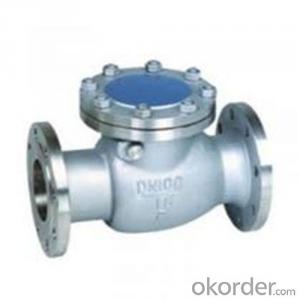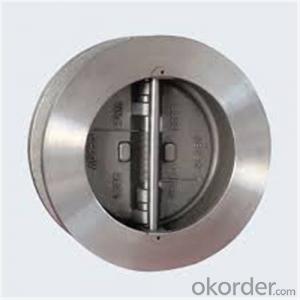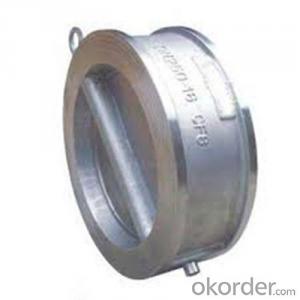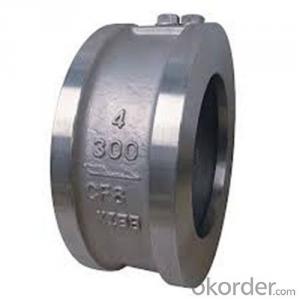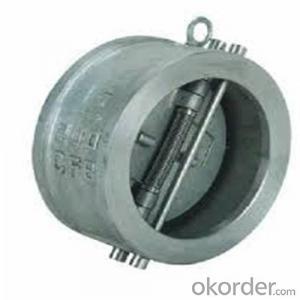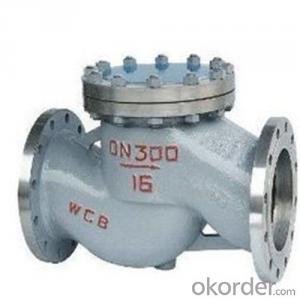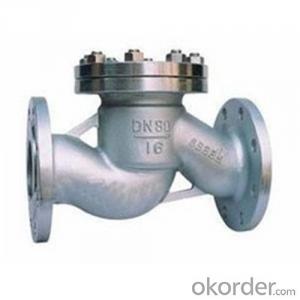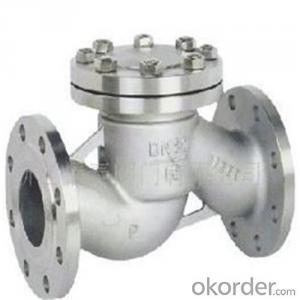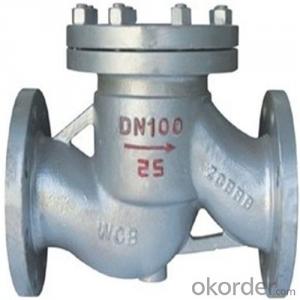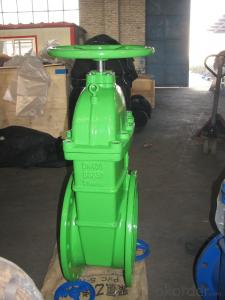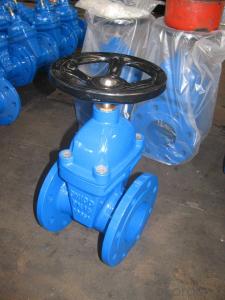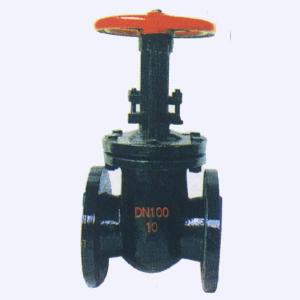API Cast Steel Lift Check Valve Size 700 mm
- Loading Port:
- Shanghai
- Payment Terms:
- TT OR LC
- Min Order Qty:
- 10 pc
- Supply Capability:
- 100 pc/month
OKorder Service Pledge
OKorder Financial Service
You Might Also Like
API Cast Steel Lift Check Valve 150 Class
The features of Cast Steel Lift Check Valve
Bolted Bonnet;Swing and lift disc;Metallic seating surfaces.
Body and Bonnet Connection of Cast Steel Lift Check Valve:
The body and bonnet of Class150~Class900 check valves are usually with studs and nuts.And the body and bonnet of Class1500~Class2500 check valves are usually of pressurized seal design.
Body-To-Bonnet Joint of Cast Steel Lift Check Valve:
Stainless steel + flesible graphite wounded gasket is used for Class 150 and Class 300 check valve;Stainless steel + flexible graphite wounded gasket is used for Class 600 check valve,and joint gasket is also optional for Class 600 check valve;Ring joint gasket is used for Class900 check valve;Pressurized seal design is used for Class 1500~Class 2500 check valves.
Seat of Cast Steel Lift Check Valve:
For carbon steel check valve,the seat is usually forged steel.The sealing surface of the seat is spray welded with hard alloy specified by the customer.Renewable threaded seat is used for NPS<10 check="" valves="" and="" welded="" on="" seat="" can="" be="" also="" optional="" if="" being="" requested="" by="" the="" customer.welded="" is="" used="" for="" nps="">12 crbon steel gate valves .Forstainless steel check valve,integral seat is usually adopted ,or to weld hard alloy directly integrally.Threaded or welded on seat is also optional for stainless steel check valve if being requested by the customer.
Parameter of Cast Steel Check Valve:
Standard Criteria | ASME/ANSI/API customize |
Pressure Rating | 150 Class 300 Class 600 Class 900 Class 1500 Class 2500 Class customize |
Valve Size | 50 mm 65 mm 80 mm 100 mm 125 mm 150 mm 200 mm 250 mm 300 mm 350 mm 400 mm 450 mm 500 mm 600 mm 650 mm 700 mm 750 mm |
2 inch 2.5 inch 3 inch 4 inch 5 inch 6 inch 8 inch 10 inch 12 inch 14 inch 16 inch 18 inch 20 inch 24 inch 26 inch 28 inch 30 inch customize | |
Actuator | Automatic customize |
Connection | Butt Welding Flange RF Flange RTJ customize |
1-Body Material | A216 WCB A351-CF8 A351-CF8M customize |
2-Seat ring | A351-CF8 A351-CF8M A105+13Cr Tool Steel+A105 customize |
3-Disc | Tool Steel+A216 WCB A351-CF8M A351-CF8 A216 WCB+13Cr customize |
4-Arm | A351-CF8 A216 WCB A351-CF8M customize |
5-Nut | A194 8M A194-8 A194 2H customize |
6-Arm pin | A182-F6a A182-F316 A182-F304 customize |
7-Yoke | A351-CF8 A351-CF8M A216 WCB customize |
8-Bonnet nut | A194 8M A194-8 A194 2H customize |
9-Bonnet bolt | A193-B8 A193-B8M A193-B7 customize |
10-Bolt | A193-B7 A193-B8 A193-B8M customize |
11-Gasket | graphite+304 graphite+316 customize |
12-Bonnet | A216 WCB A351-CF8M A351-CF8 customize |
13-Eye bolt | A181 customize |
Design Standard | API 6D BS 1868 customize |
Connection Standard | API 605 ASME B 16.25-2007 ASME B 16.47A ASME B 16.47B ASME B 16.5 MSS SP-44 customize |
Test Standard | API 598 API 6D customize |
Face to Face | ASME B 16.10 customize |
Pressure-temperature ratings | ASME B 16.34-2004 customize |
Wall thickness dimension | API 600 BS 1868 |
FAQ of Cast Steel Check Valve:
Q1:I can’t find the type of steel check valve which I need. what can I do?
The chart above only lists out some common composition of steel check valve parts.We may provide other different parts material composition according to the customer's request or the actual valve working condition.
Q2:Which certification do your products pass?
Our products are in accordance with ISO 9001、ISO 14001、API 6A、API 6D、TS CE、API607/6FA/BS6755.
- Q: We have a 2008 grizzly 700...Lately when we run the 4-wheeler there is a ticking like noise (as is something were loose). I have been told by a few people that it sounds like the valves need adjusting. Does that sound like what it is? Will it cause any damage to the 4-wheeler if we ride it before we get a chance to adjust the valves?
- They are correct. Well almost. The Rockers are what can be adjusted. They are too far away from the valve and are starting to hammer on them instead of just moving them. You will not cause immediate damage by riding it but you could wear out the rocker completely and drop a valve into the engine which would be very costly. Best to get it repaired soon. Make sure they install new rockers and springs. The main cause for this is poor oil maintenance or poor grade of oil being used. Always use a GOOD synthetic oil and your motor will last 10 times as long
- Q: Hi. I replaced my PCV valve but the hose it connects to is cracked at the end. It's still loose and I can pull it off with my hand. It is very hard to get it to stay connected. So my question is that while I am driving, what would happen if the PCV valve accidently disconnects from the hose? Would I still be able to get to a service center?
- Depends on the vehicle, most cars may run rough, sluggish, some wont even run, every car is different on how much actual vacuum is running through the pcv valve that will determine if its drivable. Run it for a minute..drive it around the block make sure it wont die...then take to the shop.
- Q: hello my names matt and i have a 1997 eclipse 2.0 non turbo with 94k miles and the semi circul seal on my valve cover gasket has a small leak that i see oil dripping and i dont think the pcv valve has ever bin replaced could any of those cause my exhaust to burn oil maby a bad fuel injector? theres no oil in the top of the engine on the spark plugs when i check them all, the piston rings and the headgasket r not worn or cracked so idk what it could be some one please help
- the valve stem seals are common leak on these I work with a lot of mitsubishi's
- Q: I am looking at getting a baritone horn of my own, but am not sure what compensating versus non-compensating valves are?
- It okorder /
- Q: OK, I would like to run my shorty headers open on my Camaro, but I have two questions.1. I heard valve damage may occur because cold air gets in there. Why isn't this the case with straight pipe exhaust, doesn't the cold air travel to the valves in that case anyway?2. Right now with my headers to off road y pipe I have 2 o2 sensors to throw the check engine light off, and it has worked. If I run open headers, will they still work?
- Cold air doesn't get in to damage, but the valve needs a bit of back pressure. The valve will burn, crack or check, or the valve seat will do the same. The common damage is a small w crack on the valve face, which then leaks compression gases into the hot header resulting in erratic backfire and misfiring. The lack of back pressure can be compensated for by richer mixture, or grinding a wider seat. Get used to lapping in valves, or find some high performance sodium valves and stelite seats. You could run dumps, and only open the headers for short blasts.
- Q: My husband went to the doctor today, then called to say he won't be coming home because he has infective endocarditis. They sent him to another, larger, hospital in the region. Hours later he called and said that he needs surgery on the valve and they are moving him to another part of the country. I've been trying to read about it but I'm not sure I understand. What I've read says that they have to treat the infection with penicillin first, the he can have surgery. However, he's telling me he might have surgery when he get to the other hospital. He needs a new valve. Does this mean that his condition is worse than those I've read about or that they are simply doing things differently? Also, if you know. Does other illnesses make the risks much higher? He's got aspergillus in his lungs and have had 2/3 of the lungs removed. He has an immune deficiency (HIES) and he is physically weak from being sick. I know it's not good, but how bad is it?
- There are risks in any surgery - no matter how major or minor. Overall health condition also plays an important role in his recovery. Being he has an infection which could be life-threatening, treating him and having him go through this procedure gives him more chance of survival. The doctors have weighed the pros and cons of him having this procedure and feel this is the best way to proceed. They will do their best to help and take care of him.
- Q: so here are the details. i've been using my trumpet for about 6-8 years now and 1 if not 2 valves get stuck on my trumpet. the problem is not the oil as i have over oiled them too and no go. its that when i try to put my valves back in their place and twist them they don't stay in place,move ,and making either my valves stuck or making my trumpet not do a sound. what should i do? repair shop or buy a new one? i hear the clicking sound when i put them back but still all that does is either make my valve more sticky
- Trumpet valves have metal or plastic tabs that fit into grooves on the casing. They keep the valve in allignment. It sounds like the tabs on your horn could be broken. I suggest letting a repair shop do the work.
- Q: I'm drawing a complete diagram of the heart, but I'm unsure of the positions of the different valves. I know there are the pulmoary valve, the aortic valve, tricuspid/right AV, bicuspid/left AV, semilunar valves, mitral...but I know there are several names for some of them, like I think the mitral and the bicuspid are the same...but there are so many sources online I don't know which to believe. If anyone knows for absolute sure the right names and where they are it would be very appreciated if you could help :)
- the bicuspid is the same as the mitral valve it seems like anatomy has 12 names for everything In anatomy, the heart valves maintain the unidirectional flow of blood in the heart by opening and closing depending on the difference in pressure on each side. They are mechanically similar to reed valves. There are four valves in the heart (not counting the valve of the coronary sinus, and the valve of the inferior vena cava): The two atrioventricular (AV) valves between the atria and the ventricles, also called tricuspid and bicuspid. The two semilunar (SL) valves, in the arteries leaving the heart, also called pulmonary and aortic. This I know for sure. Drawing pictures always helped me keep it straight and I just got an A in anatomy. best of luck to you
- Q: i have a nos tank that my grandfather gave me and i was wondering if i could get a scuba valve and put it on there so i can fill my paintball tank up with the air so i dont have to go buy a scuba tank
- srry but if u do that it works very poorly so i would buy that scuba tank
- Q: i got a filler neck for my dodge dakota and was wondering how to put it on. can anyone send me a link or help me. and also what does my EGR valve look like and i cant seem to find a new one not even at the dealer. i was told to clean it how do i do this. can someone send me a link or pic what it look like. thanks
- The VECI decal map under your hodd will show you EXACTLY where your EGR valve is. You may need a magnifying glass. The valve can be removed and cleaned with Gum-out or foaming cleaner (amsoil). When you are done, re-install the valve. While you are getting ambitious, clean your throttle body and plate, and the IDLE AIR CONTROL VALVE. A dirty IAC is the most prominant reason for the EGR valve to clog up. Running Gum-out through your intake system will clean out your O2 sensors, as well. Good luck!!
Send your message to us
API Cast Steel Lift Check Valve Size 700 mm
- Loading Port:
- Shanghai
- Payment Terms:
- TT OR LC
- Min Order Qty:
- 10 pc
- Supply Capability:
- 100 pc/month
OKorder Service Pledge
OKorder Financial Service
Similar products
Hot products
Hot Searches
Related keywords
